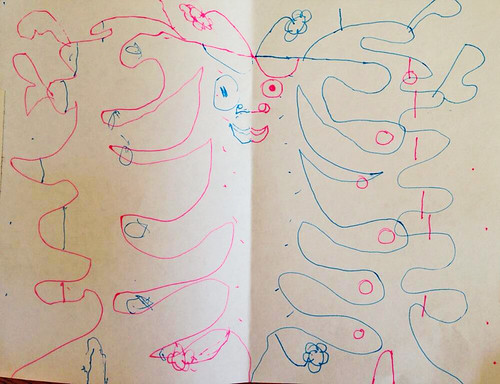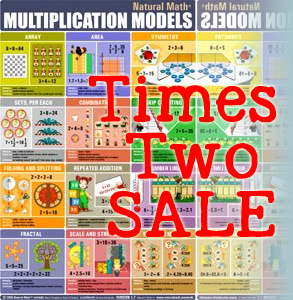Camp Logic : special edition of newsletter, May 14, 2014
Subscribe to Moebius Noodles newsletters
Pinterest | Twitter | Facebook | Google+
I am Moby Snoodles, and this is my newsletter. Send me your questions, comments, and stories of math adventures at moby@moebiusnoodles.com

Deep and playful mathematics for older kids
If you played through the Moebius Noodles book, participated in our multiplication course, or followed the Inspired by Calculus posts – and wished for playful and deep math like this, but for older kids – then I have great news for you! I am very happy to present Camp Logic by Mark Saul and Sian Zelbo, a book we will produce this year. I first met Mark at a conference of the National Association of Math Circles. Every Math Circle has a unique flavor; not all are compatible. I knew right away that Mark and I share many design principles and education values. In their math circles, Mark and Sian invite children to explore the underlying structure of mathematics through playful and informal tasks. And in Camp Logic, Mark and Sian share their art and craft with parents and teachers.
Crowdfunding: help to publish Camp Logic!

Here is Mark and Sian’s announcement from our crowdfunding page:

 Camp Logic is a book for teachers, parents, math circle leaders, and anyone who nurtures the intellectual development of children. It is not necessary to have any mathematical background at all to use these activities – only to have a willingness to dig in and work toward solving problems where there is no clear path to a solution.
Camp Logic is a book for teachers, parents, math circle leaders, and anyone who nurtures the intellectual development of children. It is not necessary to have any mathematical background at all to use these activities – only to have a willingness to dig in and work toward solving problems where there is no clear path to a solution.
You can help us publish Camp Logic! Let your friends, colleagues, and the world know you want children to enjoy the underlying structures of math: share the campaign’s page on your sites, blogs, and social media. Join the crowdfunding event to contribute money for editing, printing, and distributing the book, and to field test the activities. The book will by published in 2014, under an open Creative Commons license.
Mark Saul and Sian Zelbo, authors
What parents and math circle leaders say

Sandy Papanek, a math circle parent: Congratulations, Sian and Mark! You have inspired so many children in our community. Now kids (and adults) all over the world will have access to your brilliant and exciting approach to math.
Ashley Ahlin, Michigan State University camp leader: I’m planning our summer math camps at MSU, and would love to use some of this material!
Amanda Serenevy, director of the Riverbend Community Math Center: I look forward to using this book with our students!
Kathy MacGovan, a math circle parent: Sian gave my daughter the gift of Math! A girl who was not sure about it was transformed into a confident, excited, inventive student.
May her book inspire hundreds of children in the same way. Congratulations Sian!
Chapter preview unlocked for everyone

The draft of the book is already written, discussed with experienced math circle leaders, and illustrated. We are conducting broader beta testing during this crowdfunding campaign. Contributors have a chance to give their feedback for all parts of the manuscript. The campaign reached its first milestone within two days of its start, and now preview and commenting on the first chapter is open for the general public.
Read about Mark and Sian, see the chapter, and learn more about the book at the campaign’s page.

Sharing
You are welcome to share the contents of this newsletter online or in print.
Talk to you soon! Moby Snoodles, aka Dr. Maria Droujkova
Posted in Newsletter
Parents, help, and wishes
Parents often ask how to help kids do math projects without upsetting the kids, taking over, or otherwise breaking the flow.
“Every time I correct my child’s mistake she starts crying.”
“We started to build a model, but as soon as I helped, my son stopped working!”
Our recipe is simple. It is similar to the advice, “Don’t answer questions nobody asked.” Be co-workers, doing separate projects side by side. Do what you want – on your side, on your project. And help kids do what they want, on theirs. Don’t impose your wishes on children’s projects.
Help kids do what they want.
Ask kids to help you do what you want.
Don’t help kids do what you want.
I mean, would you want someone to help you do something that person wants, not you? Exactly!

Posted in Grow
Rachel’s question: What should you do when you’re bored in math class?
Please help Rachel with her question! What should you do when you’re bored in math class?
Posted in Grow
Kids tackle dimensions, mistakes on purpose, Poster*2 sale: Newsletter May 1, 2014
Subscribe to Moebius Noodles newsletters
Pinterest | Twitter | Facebook | Google+
I am Moby Snoodles, and this is my newsletter. Send me your questions, comments, and stories of math adventures at moby@moebiusnoodles.com

Poster*2 to celebrate multiplication
Have you seen our multiplication models poster? If you have wanted to get one, now is the perfect time! For any number of posters you order in the next two weeks, we will send you twice the number of posters. This is our way of celebrating our Natural Math Multiplication course and the ~600 registered participants. Thank you for all the stories, music, art and craft in virtual and physical media!
To quote Malke Rosenfeld of Math in Your Feet: I mean, just look how many ways we can experience and come to understand multiplication! Stunning. Given this reality, why would we want our students to only understand multiplication as a series of facts?
Math Spark: Point-Line-Shape-Shape-Shape…

Staple some paper together into a little book, or use a small notebook. You will make your own counting book of dimensions.
Page 1
What to do: Draw a point.
Where’s the math: In the world of math, points have no width, height, length, anything – they are zero dimensions. And they belong to the 0-th dimension.
Page 2
What to do: Make a line out of points. This process is called integration. Is your line straight or curvy? Does it form your favorite letter? Now that I have asked these questions, do you want to integrate more, fancier lines? Have you used many points?
Where’s the math: Mathematical lines use infinitely many points! If you know where you started on the line, and how far to go, and which way (+ or -), you can find one precise destination unambiguously. Think about it: however your line curves in space, if you are a Line-Land citizen, you don’t care. Just knowing one number (positive or negative) gives you all the information about your destination. This means that whatever line you drew, however it curves or angles, it is of the 1st dimension.
Page 3
What to do: Integrate a flat shape out of lines. Will your lines crisscross or stay parallel? Does your shape resembles anything or is it abstract? Can you still see the lines within it?
Where’s the math: In the world of mathematics, flat shapes are made of infinitely many lines, and belong to the 2nd dimension.
Page 4
What to do: The second dimension is as far as you can directly model on paper!
You can draw a stack of 2D shapes, faking the 3rd dimension. Or you can make a bookform or a sliceform pop-up of your shapes, and insert it into your book.
Where’s the math: In mathematics, a volume is made up of infinitely many 2-dimensional slices.
Beyond Page 4. You can draw and imagine shapes in higher dimensions! More details at https://naturalmath.com/2014/04/inspired-by-calculus-math-circle-week-5/
Watch a short animated cartoon, The Dot and the Line: A Romance in Lower Mathematics.
Have a math spark from your family or group? Email us so we can share your adventures on the blog!
Join us at Maker Faire North Carolina
On Saturday June 7th, we will be at the Maker Faire, celebrating the DIY spirit in mathematics. If you are going, come say Hi at the Natural Math station at the Faire. Email me to volunteer to help us design and lead activities. Even if you are not local, send us ideas for crowd-pleasing, math-making activities!

Book news
Dee Harvey shared a fantastic “pattern creature” by Iseult (6), inspired by mirror-drawing activities from the Moebius Noodles book. Check out the attention to detail in reflections, for both shapes and colors!

Blogs and networks
Our Math Mind Hack about making mistakes on purpose is generating some following – and some objections! Dana Ernst at Math Ed Matters used the method in her study of combinatorics of Coxeter groups: I set myself the task of trying to come up with clever mistakes. I intentionally followed what I expected to be dead ends. An hour later, I had several new insights. I still haven’t cracked the problem, but for the first time in a while I felt like I had made some headway.
Dana asks her readers how to help students develop healthy attitudes and practices around mistakes. In several responses, the topic of play comes up, since mistakes are handled gracefully in many playful contexts. For example, Christopher Hanusa suggests games such as Planarity, where you make a lot of experimental mistakes before figuring out the solution to your graph theory problem.
Play was also a major theme in my Learning Revolution keynote, and in questions people asked.
However, the invitation to make mistakes on purpose raises some red flags during discussions at the Multiplication course forum. You can see my comments there. @cleabs says the very idea can alarm a very anxious, perfectionist child:
Celebrating mistakes is also part of what we do, but she just doesn’t buy it. Like the other day we were making gluten free donuts in our new donut pan, and both batches came out tasty but not donut shaped. She cried! I was like – no, this is fine, it’s our first attempt, we learned this recipe doesn’t work, we learned this other recipe needs tweaking but we’re closer, etc. – and it just didn’t make a difference. She is phobic of making mistakes despite how she has been taught (and I think is partly just genetic hardwiring) in any field, and since there is a “right” and a “wrong” in math, she has a lot of fear here.
And @katying points out two potential conflicts: with applied math, and with standing on the shoulders of the giants:
I homeschool my son. He is only 5 right now. But one reason I like it already is that as his mother I know him so well, I know when he is tired, stressed, over worked, bored and silly and so I know when to push a bit further and when to pull back. We have fun and are silly at times, and he likes to make erroneous math sentences and have me correct them, or he likes when I make the mistake and he corrects them. This is fun because I know in a round about way, it confirms for me what he knows and doesn’t know, which I am always keeping an unwritten log of. But I also think the goal of mathematics is to measure the world. In my homeschooling we have plenty of room for mistakes and practices, but I do intend for him to be a serious student of the world, and to have reverence and respect for teachers and adults and the thinkers who came before him… I guess I am not sure to what extent or in which context I agree with the idea of celebrating mistakes…
Does making mistakes on purpose bother you? How can you use mistake as a tool without building faulty bridges, disrespecting Newton and Kovalevskaya, or triggering your panic attacks? Share your thoughts!
Sharing
You are welcome to share the contents of this newsletter online or in print.
Talk to you soon! Moby Snoodles, aka Dr. Maria Droujkova
Posted in Newsletter





